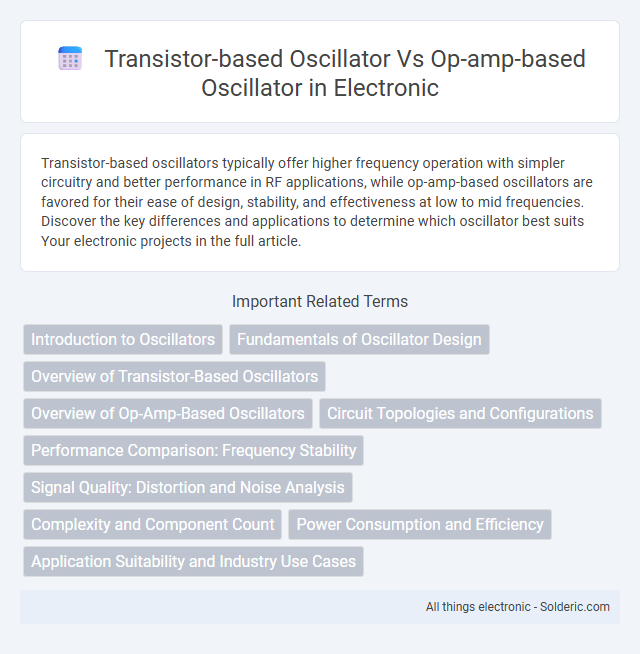Transistor-based oscillators typically offer higher frequency operation with simpler circuitry and better performance in RF applications, while op-amp-based oscillators are favored for their ease of design, stability, and effectiveness at low to mid frequencies. Discover the key differences and applications to determine which oscillator best suits Your electronic projects in the full article.
Comparison Table
| Feature | Transistor-Based Oscillator | Op-Amp-Based Oscillator |
|---|---|---|
| Core Component | Bipolar Junction Transistor (BJT) or FET | Operational Amplifier (Op-Amp) |
| Frequency Stability | Moderate; affected by transistor parameters and temperature | High; stable due to high gain and feedback design |
| Simplicity | Simple to moderate complexity | Moderate complexity, requires feedback network |
| Amplitude Control | Manual or using non-linear components | Automatic amplitude stabilization easier via feedback |
| Power Consumption | Typically lower power consumption | Generally higher power due to op-amp circuits |
| Output Signal Quality | Good sinusoidal output but may require filtering | High purity sine wave output with low distortion |
| Frequency Range | Wide, limited by transistor characteristics | Wide, determined by op-amp bandwidth and components |
| Common Applications | RF oscillators, signal generators, low-frequency oscillators | Signal generation, waveform synthesis, instrumentation |
Introduction to Oscillators
Transistor-based oscillators utilize the active region of bipolar junction transistors (BJTs) or field-effect transistors (FETs) to generate continuous periodic waveforms through positive feedback in an LC or RC circuit. Op-amp-based oscillators rely on operational amplifiers configured with frequency-determining components such as resistors and capacitors to produce stable sine or square wave oscillations with high gain and low distortion. Both oscillator types are fundamental in signal generation, but transistor oscillators often excel in high-frequency applications while op-amp oscillators provide simplicity and versatility in low to mid-frequency ranges.
Fundamentals of Oscillator Design
Transistor-based oscillators rely on the active device's gain and phase shift to sustain oscillations, typically using LC or RC networks to establish the frequency determined by the resonant circuit. Op-amp-based oscillators utilize the op-amp's high gain and feedback network, often employing RC phase-shift or Wien bridge designs, offering predictable frequency control and stability. Understanding the active element's role and feedback conditions is fundamental in both approaches to ensure consistent and reliable signal generation for Your electronic applications.
Overview of Transistor-Based Oscillators
Transistor-based oscillators utilize bipolar junction transistors (BJTs) or field-effect transistors (FETs) to generate periodic electronic signals with high frequency and stability. These oscillators are often favored for their simplicity, fast switching capabilities, and suitability in radio frequency (RF) applications where precise waveform generation is critical. Their design typically involves feedback networks and biasing to maintain continuous oscillation without external input signals.
Overview of Op-Amp-Based Oscillators
Op-amp-based oscillators utilize the high gain and feedback capabilities of operational amplifiers to generate stable sinusoidal waveforms at various frequencies. Common types include Wien bridge, phase shift, and quadrature oscillators, each designed for specific frequency ranges and applications. These oscillators offer ease of implementation, frequency stability, and low distortion, making them ideal for signal generation in audio and communication systems.
Circuit Topologies and Configurations
Transistor-based oscillators commonly utilize configurations such as Colpitts, Hartley, and phase-shift oscillator circuits, where the transistor acts as an active amplifying device to sustain oscillations through feedback networks. Op-amp-based oscillators frequently employ integrator, Wien-bridge, and relaxation oscillator topologies, leveraging the high input impedance and linear amplification properties of operational amplifiers for stable frequency generation. The choice between transistor and op-amp configurations depends on frequency range, signal purity, and circuit complexity requirements.
Performance Comparison: Frequency Stability
Transistor-based oscillators generally offer higher frequency stability because of their simpler circuitry and lower susceptibility to component variations and temperature changes. Op-amp-based oscillators tend to have more frequency drift due to the op-amp's input offset voltage and limited gain-bandwidth product, which can affect precision over time. Your choice should consider the specific frequency stability requirements of your application to optimize performance.
Signal Quality: Distortion and Noise Analysis
Transistor-based oscillators typically exhibit higher harmonic distortion and phase noise due to the nonlinear characteristics of transistors and their sensitivity to temperature variations, impacting signal purity. Op-amp-based oscillators usually offer lower distortion and noise levels because of the linear amplification and high input impedance, resulting in cleaner and more stable oscillations. You should consider op-amp oscillators for applications requiring precise signal quality and low noise performance.
Complexity and Component Count
Transistor-based oscillators typically require fewer components but involve more intricate biasing and tuning, increasing design complexity. Op-amp-based oscillators, while generally using more components, offer simplified circuit design due to the op-amp's inherent gain and stability features. Your choice depends on balancing the need for a compact circuit against ease of design and frequency stability.
Power Consumption and Efficiency
Transistor-based oscillators typically consume less power and offer higher efficiency due to their simpler circuit design and direct control over transistor biasing, making them ideal for battery-powered or low-power applications. Op-amp-based oscillators, while more versatile and easier to design with accurate frequency control, generally draw more quiescent current, leading to higher power consumption and lower overall efficiency. Understanding your power budget and efficiency requirements will help determine which oscillator type best suits your application.
Application Suitability and Industry Use Cases
Transistor-based oscillators excel in high-frequency applications such as RF signal generation and communication systems due to their fast switching speeds and simplicity, making them ideal for industries like telecommunications and aerospace. Op-amp-based oscillators offer greater stability and ease of frequency control, suiting audio signal processing, instrumentation, and sensor systems commonly found in consumer electronics and medical devices. Your choice depends on the specific frequency range, precision requirements, and power constraints of the intended application, aligning with the typical industry use cases.
transistor-based oscillator vs op-amp-based oscillator Infographic

 solderic.com
solderic.com